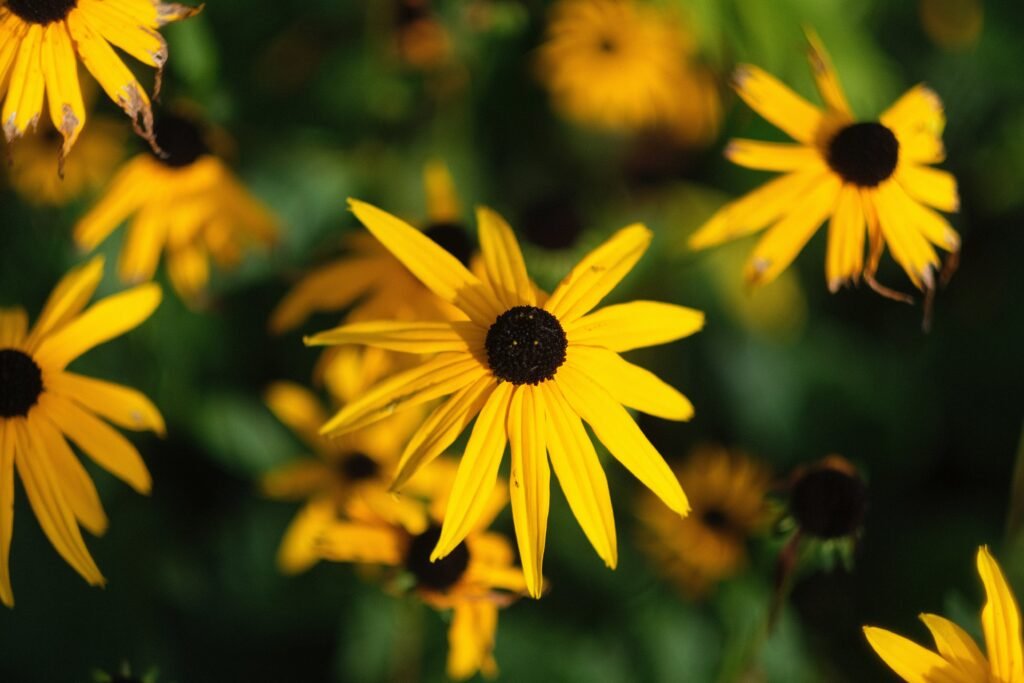About Black-eyed Susan:
Black-eyed Susan is a popular plant with various types, including Rudbeckia hirta, Goldsturm, and Prairie Sun. Each type has its own unique characteristics and growth habits.
This plant has a biennial or perennial life cycle. It blooms from mid-summer to early fall, providing a burst of color in the garden.
Characteristics:
Black-eyed Susan attracts bees, butterflies, and hummingbirds, making it valuable for pollinator gardens. It is an easy-to-grow plant with low maintenance requirements. While not edible, it has a slight fragrance. Black-eyed Susan has an extended bloom time, adding beauty to the garden for an extended period. It is often used as an ornamental plant due to its vibrant flowers and attractive foliage. Moreover, Black-eyed Susan is a fast-growing plant, quickly filling out garden spaces.
Growing Conditions:
Black-eyed Susan thrives in full sun and well-drained soil. It is drought tolerant once established and can tolerate a wide range of soil pH levels. This plant is adaptable and can grow in various soil types.
Resistance:
Black-eyed Susan is resistant to deer and rabbits, making it a great choice for gardens prone to wildlife damage. It also shows resistance to common plant diseases such as rust, fusarium wilt, downy mildew, and powdery mildew.
| Season | Depth | Height | Spacing | US Hardiness Zone |
|---|---|---|---|---|
| Spring or Fall | 1 inch | 1 to 3 feet | 18 to 24 inches | 3 to 9 |
Plant Care Instructions
Light Requirement
Black-eyed Susans thrive best in full sun to partial shade. They can tolerate full shade, but they may not bloom as profusely.
Water Need
Black-eyed Susans have average water needs. They prefer moist, well-drained soil. Water them regularly, especially during dry periods, but be careful not to overwater as this can lead to root rot.
Fertilizer
Black-eyed Susans do well with a balanced fertilizer, such as a 10-10-10 or 20-20-20. For an organic option, you can use compost or an organic granular fertilizer labeled for use on flowering plants.
Pruning
Pruning Black-eyed Susans is not necessary for their overall health, but it can help to promote bushier growth and prevent self-seeding. Deadhead spent flowers to encourage more blooms. In late winter or early spring, you can cut back the plants to a few inches above the ground to encourage fresh growth.
Toxicity
Black-eyed Susans are generally non-toxic to humans and pets. However, it’s always a good idea to keep an eye on curious pets and children around plants.
Common Issues
Common issues with Black-eyed Susans include powdery mildew, rust, and fungal leaf spots. To prevent these problems, make sure the plants have good air circulation and avoid overhead watering. If issues arise, treat them with appropriate organic or chemical fungicides.
Culinary Benefits:
- Black-eyed Susan flowers can add a pop of color to salads and other dishes.
- The petals of Black-eyed Susan are edible and can be used as a garnish.
- The flowers can also be used to make herbal teas and infusions.
Medicinal Benefits:
- Black-eyed Susan has been traditionally used in herbal medicine for its immune-boosting properties.
- It is believed to have anti-inflammatory effects and can be used to relieve minor skin irritations.
- Black-eyed Susan extracts are used in some natural remedies for respiratory conditions.
- The plant is also used in some traditional remedies for digestive issues.
Companion Plants for Black-eyed-Susan:
1. Marigolds: These bright flowers not only enhance the beauty of your garden but also repel pests and attract beneficial insects.
2. Bee Balm: With its vibrant blooms, bee balm attracts pollinators, such as bees and butterflies, which can help increase the yield of your Black-eyed-Susans.
3. Coneflowers: These sturdy perennials not only complement Black-eyed-Susans’ yellow petals with their vibrant colors but also attract bees and butterflies for pollination.
4. Russian Sage: With its silver-gray foliage and lavender-blue flowers, Russian Sage provides a stunning contrast to the bright flowers of Black-eyed-Susans and attracts butterflies and hummingbirds.

